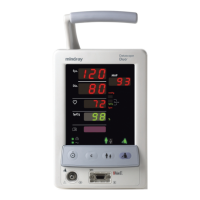Routine Operation Operation
2 - 10 0070-10-0603-01 Duo™ Operating Instructions
CAUTION: Do not place the SpO2 sensor on an extremity with an
invasive catheter or blood pressure cuff in place.
CAUTION: Tissue damage or inaccurate measurement may be caused
by incorrect SpO2 sensor application or use, such as
wrapping too tightly, applying supplemental tape, failing to
inspect the sensor site periodically or failing to position
appropriately. Carefully read the SpO2 sensor directions
and all precautionary information before use.
CAUTION: Inaccurate SpO2 measurements may be caused by:
• incorrect sensor application or use
• significant levels of dysfunctional hemoglobins, (e.g.,
carboxyhemoglobin or methemoglobin)
• intra-vascular dyes such as indocyanine green or
methylene blue
• exposure to excessive illumination such as surgical
lamps (especially ones with a xenon light source),
bilirubin lamps, fluorescent lights, infrared heating
lamps, or excessive ambient light. In such cases, cover
the sensor site with opaque material.
• excessive patient movement
• venous pulsations
• electro-surgical interference
• placement of a sensor on an extremity that has a blood
pressure cuff, arterial catheter or intra-vascular line.
• nail polish or fungus
CAUTION: In certain situations in which perfusion and signal strength
are low, such as in patients with thick or pigmented skin,
inaccurately low SpO2 readings will result. Verification of
oxygenation should be made, especially in patients with
chronic lung disease, before instituting any therapy or
intervention.
CAUTION: Many patients suffer from poor peripheral perfusion due to
hypothermia, hypovolemia, severe vasoconstriction,
reduced cardiac output, etc. These symptoms may cause a
loss in vital sign readings.
CAUTION: If the SpO2 sensor or patient cable are damaged in any
way, discontinue use immediately. To prevent damage, do
not soak or immerse the sensor in any liquid solution. Do
not attempt to sterilize.
CAUTION: When applying the SpO2 sensor to the patient, ensure
proper positioning, alignment and skin integrity. Exercise
extreme caution with poorly perfused patients.
CAUTION: Excessive ambient light may cause inaccurate SpO2
measurements. In such cases, cover the sensor site with
opaque material.

